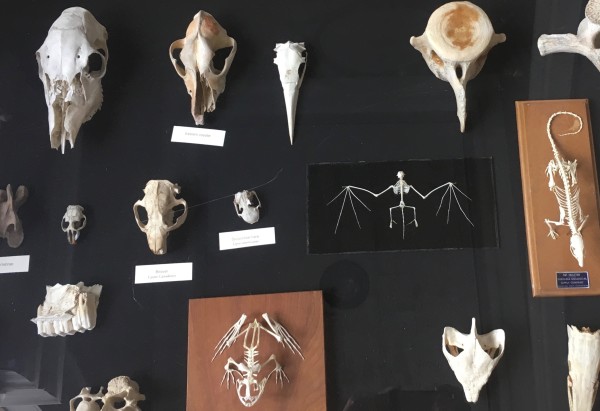
BY JAMES FW THOMPSON
When planning a fun, family outing in downtown Sydney, one typically wouldn’t think of looking at the remains of dead animals. However, that is exactly what the latest exhibit at the Old Sydney Society’s new location is proposing!
A joint exhibit between the OSS and the Department of Biology at CBU, ‘What Remains’ turns the main space at the freshly renovated Centre for Heritage and Science (the former Bank of Montreal on Charlotte St) into a mini museum of natural history. Specimens range from modern birds’ nests, to prehistoric fossils. There’s even a tiny jaw-bone from a relative of the triceratops—my personal favourite dinosaur.
While there are many different elements to the exhibit, two of the main sections are “nests” and “seashore” because, frankly, we have a lot of birds here and even more life from the sea. While some of the displays may be commonplace to those that frequently visit the woods or the shore, there will definitely be others that will be a surprise. For example: dinosaur fossils. I was not expecting that.
I visited the exhibit for a preview (the building itself is open to the public during regular hours, so if you’re ever interested in seeing how a display is set up, I suggest you take a visit right before a new one opens) and to see what it was all about. There’s a strange beauty in the remains of the creatures—some tiny like the twigs of a robin’s nest (as I learned, ‘remains’ doesn’t just mean ‘pieces of dead things’; it includes nests, shells, and other objects left behind by living creatures as well!), some only fragments of a much larger creature like vertebrae from a whale. This is no laboratory of morbid curiosities, but rather a celebration of the life that surrounds us in Cape Breton and around the world. Each piece, carefully placed with diagrams, facts, and ages, allow for viewers of any level of knowledge to enjoy.
Now, when I said above that this was a family outing, I meant it. “But, kids don’t actually get to touch the specimens, do they?” you ask. Yes. Yes, they do. They get to touch specimens. Skulls, specifically. In one exhibit, a series of skulls of a number of animals are arranged to allow kids (and adults—heck, I want to see what they feel like!) to really get a hands-on experience. It also offers a bit of trivia: can you tell the common traits? Do you know from look and feel which ones are predators? Which ones are prey? Which one is a beaver? Are any of them dinosaurs, and if so, is one a triceratops? The last question might be a little more specific and mostly for myself, but come on—you want to see a triceratops bone too!
Another interesting, hands-on display for aspiring biologists is the camera lucida (which comes from Latin meaning “light chamber”). I had no idea what this thing was, but basically it is a tool used to create incredibly accurate images of specimens. Through tracing! And it’s from the early 1800s! It’s likely that you’ve never used one (I know I haven’t) but you’ve probably seen the results that come form them in almost any biology text. The results are incredibly accurate, beautiful depictions, and now you can try it for yourself.
Most of the pieces come from the Cameron Zoological Museum at CBU. The museum was named in honour of Dr. Austin Cameron who began the collection in 1976 with animals and plants indigenous to Cape Breton. According to exhibit curator, Kellie White, Cameron himself was quite the interesting specimen and more can and should be looked up about him at the Beaton Institute! Since Dr. Cameron’s death in 1978, the collection has continued and grown, and the dream of the finished museum has continued. White hopes that the collaboration with the Old Sydney Society will continue each summer with new themes and exhibits. She also has a dream that, someday, Sydney will have its own Museum of Natural History where the collection can have a permanent home and be a resource and attraction for locals and tourists of all ages.
What Remains opens Friday, July 14th with a grand opening at 5:00pm and remains (see what I did there) until October. Admission is free. If you have any interest in life, death, or the natural world around you, I recommend you check out ‘What Remains’ at the Old Sydney Society Centre for Heritage and Science.
Centre hours: Monday to Friday, 9:00AM – 5:00PM; Saturday, 10:00AM – 2:00PM.

